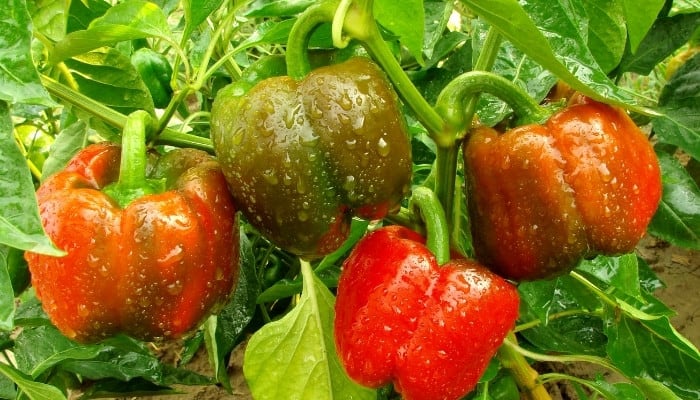The spice known as pepper, or Capsicum annuum, was introduced to Europe in 1493 and remains a staple in our diets. Despite its long history, some may encounter difficulties while trying to process this information.
Some go so far as to say that there is prehistoric evidence in Peru that proves peppers have been around for a very long time.
Peppers grow on a vine, and depending on the length of time they remain on the vine determines the final color of the peppers we see on the market.
What are the most common problems when growing peppers? Common pepper plant problems include yellow leaves, damage from various bugs, issues related to several bacterial, viral, and fungal diseases, insufficient nutrients, and watering-related problems. Providing the correct amount of heat, light, and nutrient-rich soil is key for healthy peppers.
Don’t be alarmed; the pepper plant is pretty easy to grow, and you won’t face all these problems at once.
Instead, read on and follow our comprehensive guide so you can identify problems immediately and nip them in the pepper bud!
Yellow Leaves
Yellow leaves are a sign of stress in plants. This can be down to any number of reasons, but predominantly it’s caused by a nutrient deficiency.
Identification
Leaves begin to turn pale yellow and appear limp or drooping.
Causes
- Nutrient deficiency
- Low temperatures
- Tap water
Treatment/Solution
Pepper plants grown in pots will require regular fertilizing with a balanced fertilizer or a liquid tomato feed diluted to half strength.
Fertilize once a week when flowers appear. Water the pepper plant when the top 1 inch (3 cm) of soil is dry to the touch.
Water using rainwater or tap water that has stood for 24 hours so the chlorine can dissipate.
Keep temperatures above 60℉ (15℃) by moving containers inside overnight if possible.
Curling Leaves
Curling leaves are also a sign of distress in pepper plants.
While they may indicate a pest or disease, this condition is most likely to result from a calcium deficiency, leading to improper plant development.
Identification
Leaves curl and develop brown spots. If unresolved, the leaves eventually turn yellow.
Causes
- Calcium deficiency
- Overwatering
- Plant edema
Treatment/Solution
All-purpose fertilizers and calcium supplements can be used to treat calcium deficiency. Alternatively, you can use crushed eggs shells and add them to the soil.
Eggshells are high in calcium, but can take a while to fully break down and be available for the plant, so don’t expect immediate results.
Don’t overwater the pepper plant as too much water can starve the roots of nutrients and oxygen, causing leaf curl.
Ensure the soil drains well and that plants have sufficient space for air circulation.
No Flowers
Pepper plants are temperature-sensitive plants and require warm temperatures and at least six hours of sunlight per day to thrive.
Identification
The pepper plant starts to grow but does not develop flowers. Usually, pepper plants take 60-90 days to reach full maturity.
If no flowers develop, then this indicates something is wrong with the plant.
Causes
- Cold temperatures
- Insufficient light
Treatment/Solution
Ensure the plant is not exposed to temperatures below 60℉ (15℃) at night and 70℉ (21℃) during the day.
Cold weather inhibits their growth, and your plant may not flower at all.
Instead, plant the pepper in a position where it will receive a lot of sunlight. Sunlight and warmth are critical for growth and flowering.
Flowers But No Set Fruit
Some pepper plants produce flowers, but no fruit follows.
A lack of pollination, high temperatures, nutrient imbalances, and poor soil conditions can contribute to this phenomenon.
Identification
The pepper plant appears healthy and produces flowers, but the fruit does not form.
Causes
- Lack of pollination
- Excessive heat/temperatures
- Nutrient imbalance/pH levels
Treatment/Solution
Although peppers are self-pollinating, they still required the help of the friendly bee to get the process started.
Unfortunately, bee numbers have significantly reduced due to the use of chemicals and pesticides.
Hand pollinate your flowers using an electric toothbrush. While the toothbrush is on, gently touch it to each flower.
This will simulate the sound and vibration required for the male flower part to release pollen onto the female part.
High temperatures above 85℉ (29℃) can result in pollination failure and cause the plant to lose its flowers. The optimum temperature range is 60-85℉ (16-29℃).
In addition, nutrient imbalances in the soil and incorrect pH levels can prevent the plant from producing fruit.
Soil pH should be 6.0-6.8, and fertilize using a balanced fertilizer once weekly.
Small, Misshapen Fruit
Poor or uneven pollination can result in small or deformed looking peppers. This doesn’t mean they are inedible; they look a little lopsided and on the small side.
Exposure to temperatures below 57℉ (14℃) for extended periods can result in deformed peppers.
Identification
The plant is healthy and is bearing fruit, but fruit is small and/or lopsided.
Causes
- Poor pollination
- Low temperatures
Treatment/Solution
Manually pollinate the pepper plant using a small paintbrush, swirl the paintbrush inside the flower around the anthers and pistil. This should ensure even pollination.
Ensure the plant is not exposed to low temperatures. Finally, prune the pepper plant to increase the fruit size.
Slow Growth
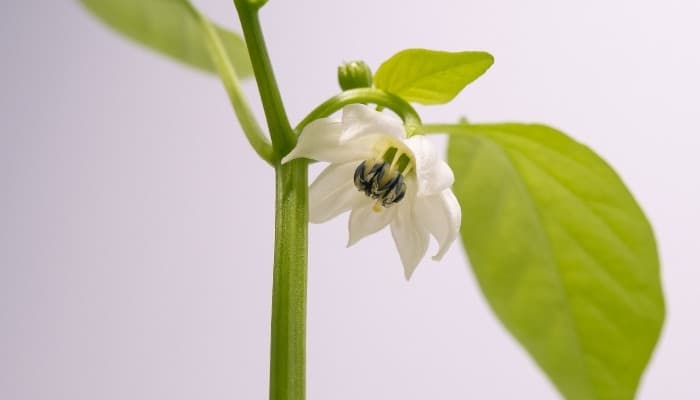
The pepper plant is a tropical plant and, as such, prefers high temperatures and warm soil.
Growth slows down when the pepper plant is exposed to low temperatures, but it can also be slow due to shock caused by transplanting or soil issues.
Identification
Growth is slow, and the plant does not reach maturity in the expected time frame.
Causes
- Improper watering
- Temperature
- Soil issues
- Transplant shock
Treatment/Solution
Temperatures below 57℉ (14℃) will slow the pepper plant’s growth. They are not frost resistant and will die off if exposed. Bring containers indoors if the temperature drops.
Overwatering can result in underdeveloped roots, while underwatering results in a weakened root system.
Feel the soil to check if it is moist to about 2 inches (5 cm) before watering.
Apply a nitrogen-rich compost (learn how to make your own compost here) or soil additive to the soil before planting, and ensure pH levels are kept between 6.0 and 6.8.
To avoid transplant shock, the seedlings will need to be hardened off gradually.
Place the new plants outside for an hour each day, increasing exposure over a period of 7-10 days.
Slugs & Snails
These are common pests of the pepper plant. They love moist, shady conditions and feed on the lower leaves of young plants in the cool evenings and at night.
In addition, the scent of ripening fruit attracts these pests throughout the growing season.
Identification
Lower leaves show the first signs of damage. The leaves have holes in irregular shapes and patterns where the slug or snail has chewed through the foliage.
Causes
- Ripening fruit
- Heavy rains/watering
Treatment/Solution
You will never rid your garden entirely of slugs and snails, especially during the spring and summer months when plants grow and provide the perfect meal for these bugs.
However, you can use non-chemical controls, such as traps and barriers made from newspaper baited with cabbage or potato, and remove the bugs from the bait daily.
Chemicals can also be used, but you should avoid ones containing the compound mesurol on edible crops as it is toxic.
Prevent these pests by planting in well-draining soil and full sun.
Avoid overhead watering to keep leaves dry and remove debris, such as dead leaves and decaying plants where slugs can lay their eggs.
A suitable method is to use crushed eggshells around your plants as slugs and snails cannot glide over the shards.
Aphids
Aphids are a common pest of the pepper plant. The plant itself is soft and filled with sap, which is great for hungry aphids.
They can range in size and color but are described as pear shaped and green or brown. They suck the sap from young leaves and stems.
Identification
Young leaves develop small dark spots along the leaf vein. The leaves may curl and start to wilt. Honeydew secretions turn into sooty mold on the leaves.
Causes
- Insufficient sunlight
- Overwatering/soggy soil conditions
- Tender leaves
Treatment/Solution
Check that the plant is receiving enough sunlight and is being watered at the appropriate intervals.
Shady, moist conditions can attract aphids to attack tender plants. Check the underside of leaves and along the stems regularly for signs of aphids and treat immediately.
Use a simple solution of 1 teaspoon dish-washing soap mixed with a cup of water, and spray the plant liberally.
You can also use neem oil (I recommend this organic neem) and horticultural soaps for aphid infestations.
Whiteflies
There are two types of whitefly that affect the pepper plant, silverleaf whitefly and greenhouse whitefly.
Both are similar in appearance and can only be told apart by their wing formation. Whiteflies are small, soft, winged insects that look similar to aphids.
They are white in color and suck the sap from leaves. They leave a honeydew residue on the leaves that turns into a sooty mold.
Identification
Leaves wilt and start to become pale or yellow. Finally, growth becomes stunted, and leaves shrivel and begin to drop off the plant.
Causes
- Lack of sunlight
- Overwatering
- Natural ageing
- Overuse of nitrogen-rich fertilizer
Treatment/Solution
Pepper plants require six to eight hours of sunlight and well-draining soil. Older plants are naturally weaker, becoming prime targets for whiteflies.
Avoid over-fertilizing as this will promote excessive leafy growth that attracts these pests.
Whiteflies are resistant to chemical insecticides. Instead, use a homemade remedy of 1 tablespoon liquid soap, two parts rubbing alcohol and five parts water.
Spray this solution onto the plant’s leaves to kill and prevent whiteflies.
Thrips
These small, slender insects are pale yellow to light brown and have two sets of wings.
They are best seen with a magnifying glass due to their size, but the damage they cause can be extensive.
Identification
Thrips feed on the young leaves and flowers of pepper plants, causing the leaves to become twisted or cup shaped.
Leaf size can be stunted and appear small, and fruit can develop scarring and discoloration. Leaves have white or silver patches with darker spots of thrip excrement.
Causes
- Crop placement
- Growing peppers
Treatment/Solution
Unfortunately, if you are growing peppers or plants that thrips enjoy, you will inevitably attract thrips.
Certain crops attract thrips in large numbers. Avoid planting pepper close to garlic, onions and cereal plants.
Prune damaged foliage, and hose down the pepper plant with short sharp bursts of water to dislodge the thrips.
Then spray the pepper plant with a solution of 4 teaspoons of neem oil, 2 teaspoons of dish washing liquid and 1 gallon of water.
Spider Mites
Spider mites belong to the same family as ticks and spiders and are so tiny at maturity that they are only the size of a grain of sand.
They go unnoticed because of their size until the plant is in obvious distress.
Identification
Spider mites suck the sap of leaves, blossoms, and the fruit of the pepper plant. As a result, the leaves curl and start to yellow. Eventually, the leaves fall off.
Severe infestations will cause the plant to die.
Causes
- Dry conditions
- Excessive levels of phosphorus or nitrogen in the soil
Treatment/Solution
Excessive fertilizing can lead to spider mites in the soil.
Fertilize once weekly when the plant is flowering with tomato feed or balanced fertilizer diluted to half the strength. Underwatering can cause dry conditions attracting the spider mite.
Water when the soil is dry to the touch. Use your finger to check the first couple of inches of soil are dry between each soaking.
Caterpillars & Worms
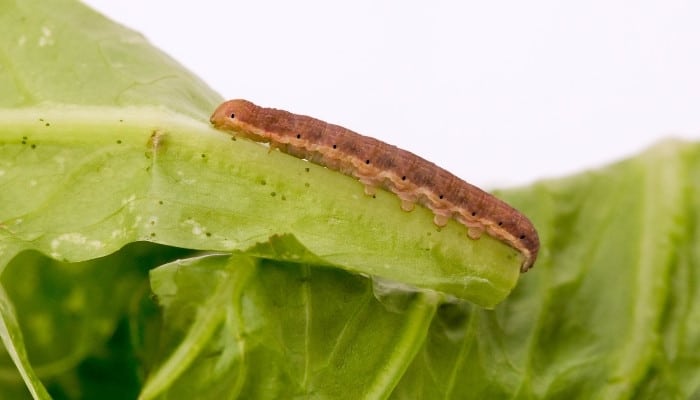
There are quite a few worms and caterpillars, such as cutworms, hornworms, and armyworms, that enjoy the succulent leaves, stems, flowers and fruit of the pepper plant.
They are really not that fussy with their diet. However, the damage is fast as these pests eat quickly and with concentration.
Identification
Prominent leaf and stem damage where the caterpillar or worm has eaten through the flesh of the plant. Holes in leaves, stems, and fruit.
Causes
- Moist conditions
- Excess garden debris
Treatment/Solution
Remove all debris from around the base of the pepper plant where eggs can be laid and hatch. Place cardboard or aluminium foil around the plant base to repel caterpillars.
Be vigilant, and remove the pests after rainy periods. Spray the plant with horticultural soap or neem oil solution to repel and kill caterpillars and worms.
Flea Beetles
Tiny hard-shelled black beetles that cause damage above and below the soil level. Did you know that they can jump?
In addition, they tend to overwinter in soil or weeds, making them an annual problem.
Identification
Leaves develop holes commonly called shot-holing caused by adult beetles chewing holes or pits into the foliage.
As a result, plant growth is inhibited, leading to eventual death if not treated. The larvae live in the soil and feed on the plant’s roots.
Causes
- Tender seedlings
Treatment/Solution
Young pepper plants or plants just reaching maturity are targets for the flea beetle due to their soft juicy stems and foliage.
Spray the plant with a soapy solution made from 1 tablespoon of dish soap mixed in half a gallon (2.5 liters) of water to deter flea beetles.
Root-Knot Nematodes
These tiny worm-like parasites are commonly found in the soil. They feed on the plant’s roots, causing them to deform and struggle with nutrient and water uptake.
Identification
The plant leaves wilt and droop due to insufficient water and nutrient levels. As a result, the fruit may be small, and the growth of the plant is stunted.
In addition, root galls develop on the roots. Severe infestations can result in plant death.
Causes
- Soil moisture
Treatment/Solution
Optimum soil moisture conditions for plant growth are also perfect for nematode eggs to hatch. Unfortunately, you can’t prevent nematodes once the plants are in the ground.
There is no solution for nematodes, and you may need to discard the plants entirely. Clean fallowing and soil solarization are options but not on a small scale.
By keeping the soil free of crops and weeds during the winter, the lack of vegetation will deprive nematodes of food.
Blossom End Rot
Blossom end rot is common in pepper plants. It’s not a form of rot, but rather the plant cannot produce healthy fruit skin.
The “rot” develops at the top or the bottom of the fruit, where newer skin develops as the fruit grows.
Identification
Fruit develops dark patches that appear rotten or soggy at the top around the stem or the base.
Causes
- Calcium imbalance
- Over or underwatering
- Incorrect fertilizer
Treatment/Solution
Prune old leaves to prevent calcium from being lost by transpiration. This increases the supply of calcium-containing water to the fruit.
Add crushed eggshells to the soil to improve calcium levels. Maintain a balanced watering routine, ensuring the soil is kept moist but not soggy.
Use a balanced fertilizer containing magnesium and calcium.
Mosaic Virus
This is a viral disease spread by pests and is resistant to fungicides. Unfortunately, there is no cure for the mosaic virus.
Identification
Plant growth is stunted, and peppers may develop blisters. In addition, the leaves form a mosaic pattern of light and dark streaks, and foliage becomes wrinkled.
Pale leaves with ring spots are also a sign of mosaic virus.
Causes
- Mosaic virus
- Pests
Treatment/Solution
Treat plants for pests such as aphids to prevent the spread of the virus. You can also soak the pepper seeds in a 10% bleach solution before planting to avoid seed-borne viruses.
Remove weeds around the plants as some are hosts of the virus.
Verticillium Wilt
This is a fungal disease that thrives in warm, wet environments. It is found in the soil and enters the pepper plant through the roots.
It prevents the uptake of water and nutrients and causes the plant to droop in warm weather.
Eventually, it takes over the whole plant, which results in death. Unfortunately, there is no cure for infected plants.
Identification
Lower leaves turn yellow and fall off while the stem becomes pale and discolored.
Causes
- Soil-borne fungi Verticillium dahliae and V. albo-atrum
- Soggy soil
- Humid temperatures
Treatment/Solution
Keep the pepper plant well watered and fed, ensuring that the soil does not become waterlogged. Remove infected plants immediately to prevent the spread of the disease.
The disease remains in the soil for up to seven years, so replanting peppers in the same area is not advised.
Blight
Phytophthora blight affects peppers and is spread by a pathogen that lives in the soil.
Lower leaves can become infected when rainwater or irrigation causes the soil to splash onto them.
Identification
Dark green lesions that are circular or irregular in shape develop on the leaves. These lesions dry and become brown.
Lesions on the fruit can be black and cause the fruit to shrivel.
Causes
- Genus Phytophthora
- Warm wet conditions
Treatment/Solution
There is no cure, so prevention is critical. Keep the soil moist but not waterlogged. Increase the soil drainage by amending the soil with compost.
In addition, check the soil is dry below the surface to a depth of 2 inches (5 cm) before watering.
Bacterial Leaf Spot
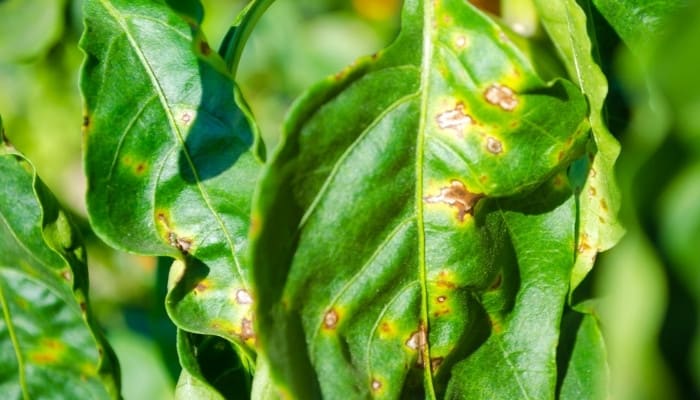
This is a common disease in peppers and can cause undersized fruit and foliage. Severe cases can result in plant death.
Unfortunately, there is no cure for this disease, but there are ways to prevent it.
Identification
Water-soaked spots develop on the leaves, which eventually turn brown with dark borders. Finally, leaves turn yellow and then eventually brown, after which they drop off.
In addition, the pepper fruit can develop rough patches that look unsightly.
Causes
- Bacterium Xanthomonas campestris pv. vesicatoria
Treatment/Solution
Avoid overhead watering as the disease is spread easily in water. Remove infected plants to prevent the disease from spreading.
Cover the soil using black plastic mulch to landscape fabric before planting.
Spray the plants every other week with an organic copper fungicide (like this one that I use) to slow down the spread of infection.
Anthracnose
This is a fungal disease caused by multiple fungi that can affect pepper plants at all stages of their growth.
The fungi can live in plant debris and on or in seeds.
Identification
Circular water-soaked lesions develop on the fruit that becomes soft and sunken. The lesions are orange-colored but eventually turn black.
In addition, gray or brown spots can be seen on the stems.
Causes
- Genus Colletotrichum, C. gloeosporioides and C. capsici
Treatment/Solution
Use a copper-based fungicide to slow the spread of the disease. Increase the soil drainage by amending the soil with compost.
Remove weeds as they can be hosts to the disease. Check seedlings for signs of disease before planting.
In addition, soak seeds in a bleach solution (one-part bleach to 10 parts water for 25 minutes).
Cercospora Leaf Spot
Cercospora leaf spot is a fungal disease that requires moisture to thrive. It can be found on old fruit in the soil but is also airborne.
The condition is spread by rain or water splash, handling infected plants, and through the air.
Identification
Affected leaves produce light brown spots with gray centers. The spots become black with a yellow halo and eventually drop off the plant.
Fruit develops dark spots and tumors encircled by halos that become sunken.
New fruit will fall off before maturing, and the fungus affecting mature fruit will dry and become tough.
Causes
- Pseudocercospora angolensis
- Warm, humid conditions
Treatment/Solution
Prevent cercospora by removing plant debris. The use of fungal spray is recommended during the rainy season when temperatures are warmer.
However, crop rotation is a safer method of reducing the recurrence of the disease.
Powdery Mildew & Downy Mildew
The pathogens that causes powdery & downy mildew prefer humid and dry conditions equally as the spores can germinate at humidity levels between zero and 100%.
The disease spreads on the wind and when handling infected plants.
Identification
White powder develops on the underside of the leaf surfaces. In addition, the upper leaf surfaces display yellow splotches. Infected leaves fall off prematurely.
Growth and fruit development are also inhibited.
Causes
- Leveillula taurica
- Humidity
- Low light
Treatment/Solution
Low light and high humidity levels are perfect conditions for germinating the spores of powdery mildew.
Peppers should be planted in bright sunlight with well-draining soil and good air circulation. Ensure plants are spaced appropriately to improve air circulation.
Fungicides can be used to control the spread of the disease, or use a home remedy of one tablespoon of baking soda, half a teaspoon of liquid soap and 1 gallon of water.
Spray liberally on the plant.
Broken Stems
Pepper plants are quite tender, and the stems can break or snap in inclement weather or even when the fruit has developed and become heavy.
However, this clever plant can regenerate even if its main stem is broken!
Identification
The main stem or stems are broken off or partly broken off the plant.
Causes
- Bad weather
- Heavy fruit or foliage
Treatment/Solution
Use a dowel or stake and tape to form a splint for the injured plant. Place the broken pieces together and bind the stake or support along the edge using the tape to hold it in place.
Support the stem if required to reduce pressure while it heals. This method is not always guaranteed to work; however, with a bit of cosseting, your pepper plant may rejuvenate with time.
Sun Scald
Excessive exposure to sunlight can cause injury to both fruit and young leaves.
Identification
The leaves and fruit display black or white discoloration that feels dry and crispy.
The fruit will develop spots that become soft initially. These will be dark spots that will turn white over time.
Damaged fruit is susceptible to fungal disease and bacteria, causing moldy, rotting fruit.
Causes
- Exposure of tender fruit and leaves to excessive heat and sunlight
Treatment/Solution
New seedlings should be hardened off before you plant them outdoors.
Place the seedlings outdoors for a few hours each day, gradually increasing the time spent outdoors over seven to 10 days.
Fertilize regularly when the plants are young to ensure a good leaf canopy growth that can provide sufficient shade for the fruit at maturity.
Plant shade-providing plants around your peppers, or invest in shade cloth to cover the plants.
Tough or Wrinkled Skin
Peppers growing on the plant can become tough, wrinkled, and shriveled for a variety of reasons.
Stressors such as pests, wilts, viruses and the environment can all put the plant under enough stress to shrivel up.
Sun scorch and windburn can also cause wrinkling and shriveling. Your fruit may become tough and wrinkled before it is mature enough to harvest.
Identification
The fruit starts to shrivel and wrinkle – it may even look a bit deformed.
Causes
- Pests
- Wilt
- Viruses
- Sun scorch
- Windburn
Treatment/Solution
Each of the causes of the pepper fruit becoming tough and wrinkly has already been covered in earlier sections.
The first step is to determine what the cause is before following the suitable course of action recommended above.
See the above sections for pests, wilt, viruses, and sun scald treatments.
Green Peppers Won’t Turn Colors
Ripe peppers are usually red, but some peppers don’t change color and remain green even though ripe.
Some varieties simply take longer to ripen, especially larger peppers.
Identification
Peppers remain green after they are fully matured.
Causes
- Immaturity
- Insufficient sunlight
Treatment/Solution
Leave the pepper on the plant until red, ensuring the plant is receiving enough sunlight.
For harvested peppers, place them on a warm windowsill with access to sunlight for a few days.
5 Key Tips for Success When Growing Peppers
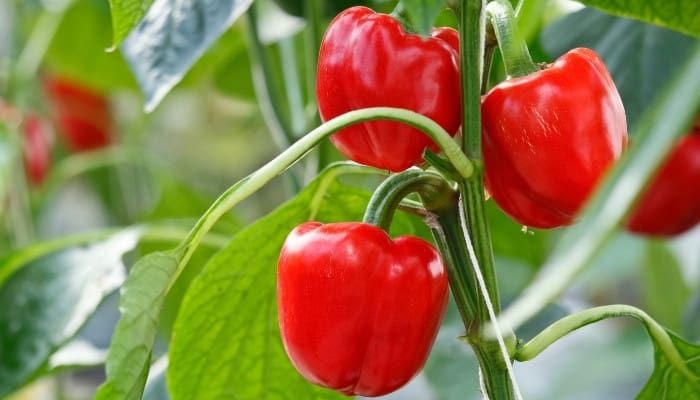
- Peppers thrive in warm soil and temperatures ranging between 60-85℉ (16-29℃).
- Fertilize using a nitrogen-rich compost.
- Protect from cold temperatures to prevent slow growth.
- Check regularly for signs of pest or disease.
- Add crushed eggshells to the soil to improve calcium uptake.
Conclusion
Peppers are super healthy. They aren’t full of calories and are a superfood loaded with vitamins A and C, folic acid, fiber and potassium.
So it’s no wonder gardeners enjoy growing this lush nutrient-filled fruit. Use this comprehensive guide to keep your pepper plants bulging with healthy peppers ripe for the dinner table!

